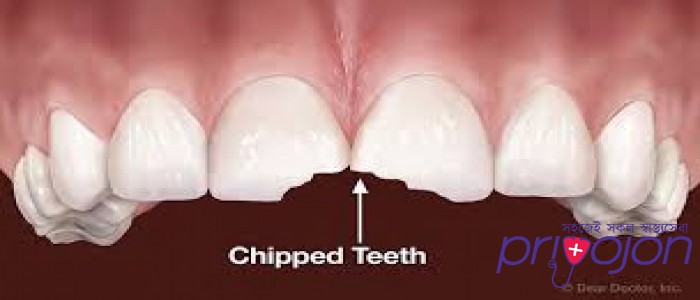
Overview
Medically reviewed by Dr. Rabeya Afroz Shomi
What is Cracked or Broken Tooth?
A tooth fracture is a break or crack in the hard shell of the tooth. The outer shell of the tooth is called the enamel. ... Cracked tooth—the tooth cracks from the chewing surface down toward the root of the tooth. Split tooth—cracks down through the root, separating a section of tooth.
Causes of a cracked tooth :
Teeth crack because of a variety of issues, including:
- pressure from teeth grinding
- fillings so large they weaken the integrity of the tooth
- chewing or biting hard foods, such as ice, nuts, or hard candy
- blows to the mouth, such as might happen with a car accident, sporting injury, fall, or even a fistfight
- abrupt changes in temperature in the mouth — for instance, from eat something extremely hot and then trying to cool your mouth with ice water
- age, with most teeth cracks occurring in people over 50.
Types of cracked teeth :
Cracks can appear as:
- Craze lines. These are super-small cracks in the enamel (the strong outer covering) of teeth. They cause no pain and don’t require any treatment.
- Fractured cusp. This kind of crack generally occurs around a dental filling. It usually doesn’t affect the pulp of the tooth (the soft center of the tooth where nerves, connective tissue, and blood vessels are) and as a result doesn’t cause much pain.
- Cracks that extend into the gum line. A tooth that has a vertical crack that extends through it but hasn’t yet reached the gum line is generally savable. However, if the crack extends into the gum line, that tooth may need to be extracted. Prompt treatment offers the best chance of saving the tooth.
- Split tooth. This is a tooth with a crack that travels from its surface to below the gum line. It can actually be separated into two segments. With such an extensive crack, it’s unlikely the entire tooth can be saved, but your dentist may be able to save a portion of it.
- Vertical root fracture. This type of crack begins below the gum line and travels upward. It often doesn’t produce much in the way of symptoms, unless the tooth becomes infected. Chances are the tooth will have to be extracted.
Symptoms of a cracked tooth :
Not every cracked tooth will produce symptoms. But when it does, common ones include:
- pain when chewing or biting, especially when you release the bite
- sensitivity to heat, cold, or sweetness
- pain that comes and goes, but is rarely continuous
- swelling of the gum around the affected tooth.
Diagnosing a cracked tooth :
X-rays don’t also reveal a cracked tooth, and not everyone has typical symptoms. To help diagnose a cracked tooth, your dentist will probably do the following:
- Ask about your dental history, such as whether you chew on a lot of hard foods or grind your teeth.
- Make a visual examination. Your doctor may need to use a magnifying lens to see tiny cracks.
- Feel for the crack. Your dentist may run a dental explorer over and around the tooth to see if it “catches” on an edge.
- Use a dental dye, which can make the crack stand out.
- Probe your gums looking for inflammation. This technique is especially helpful in identifying vertical cracks, which can irritate gums.
- X-ray your teeth. While this won’t necessarily reveal the crack, it can point out poor pulp health, which can indicate a crack is present.
- Have you bite down on something. If you have a cracked tooth, you may feel pain when you release your bite.
Treatment for a cracked tooth :
Treatment depends on the size of the crack, where it’s located, your symptoms, and whether the crack extends into the gum line. Depending on those factors, your dentist may recommend one of the following:
Bonding
In this procedure, your doctor uses a plastic resin to fill the crack, restoring its look and function.
Crown
A dental crown is a prosthetic device usually made of porcelain or ceramic. It fits over the damaged tooth or caps it.
To fit a crown, your dentist first shaves off some enamel from your tooth to make room for the crown in your mouth. They then make an impression of the tooth, pick out a color that matches your teeth, and send the impression off to a dental lab to make the crown.
This process may take a couple of weeks. When the crown returns, your dentist fits and cements it over your cracked tooth.
With advances in technology, some dentists can mill a porcelain crown right in the office and place it that day.
With proper care, a crown can last a lifetime.
Root canal
When a crack is so extensive it extends into the pulp, your dentist, or a specialist such as an oral surgeon or endodontist, will recommend a root canal to remove damaged pulp and restore some integrity to the tooth. This procedure can prevent the tooth from becoming infected or weakening further.
Extraction
When the structure of the tooth, and the nerves and roots that lie below it, are very damaged, removing the tooth maybe your only option.
No treatment
Many people have tiny, hairline cracks in the enamel of their teeth. If these cracks don’t affect appearance and don’t produce pain, your doctor may advise leaving them alone.
